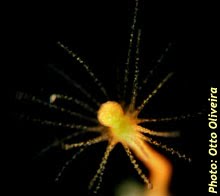Medusae are the basis of commercial fisheries in different parts of the world, particularly in tropical and subtropical waters of Asia and constitutes a business of millions of dollars per year. In the last 10 to 20 years, an increase in jellyfish demand mostly by China and Japan coincided with a reduction of stock sizes of Asian edible species generating the need of exploring new markets overseas. Consequently, new jellyfish species started to be exploited and exported to Asia in U.S.A, Mexico, Australia and India among other countries. Moreover, new reasons for fishing jellyfish have appeared recently since the possibilities of extracting collagen for medical and cosmetic issues are currently under study. Under this scenario we have wondered if a new potentially important commercial activity can be developed in South America.
To be successfully exploited a fishing resource need to fulfil at least two key features: it has to present economical value and it has to be abundant enough. Owing to their organoleptic properties and their relatively large size, 90% of the edible species belongs to the order Rhizostomeae. In South America, five rhizostomes species occur and, among them, only Lychnorhiza lucerna would be abundant enough. Therefore, we started to study the possibilities of developing a jellyfish fishery considering only this species. To this, we processed L. lucerna bells following the available “traditional” techniques bringing the obtained product to a company in Japan to be evaluated by experts. Simultaneously, we studied their life history and population dynamics including its life cycle, reproductive strategies and patterns of occurrence, abundance and biomass in the Río de la Plata estuary.
We found that L. lucerna presents biomasses which would allow the development of a jellyfish fishery at small-to-medium scale. Besides, local fishermen are able to fish and process these medusae at low cost by utilizing the boats, fishing gears, and processing plants they commonly utilized for the traditional fishing resources (fishes). Besides, this species occurs in the region during summer, in coincidence with the low income season. Thus, the jellyfish trade could represent an important additional profit for this fishermen community. On the other hand, L. lucerna presents organoleptic properties (proteins, fats, and water content) comparable to those of the currently marketed ones. Owing to these properties, it is feasible to obtain from their bells a product of suitable quality. Finally, the global increasing food demand could trigger an increase of prices giving to the fishery higher chances of development. Under the described scenario, some Asiatic companies from China and South Korea became interested in getting information about the feasibility of a jellyfish fishery in the region.
Consequently, the ecological characteristics of L. lucerna, their low fishing and processing cost, the increasing demand of jellyfish, and the economic needs of local fishermen, indicate that the development of a jellyfish fishery in Argentina is viable in the future.
For further information:
- Omori, M. and Nakano, E. 2001. Jellyfish fisheries in southeast Asia. Hydrobiologia 451: 19–26. doi: 10.1023/A:1011879821323
- Hsieh, Y-H.P.; Leong, F-M. and Rudloe, J. 2001. Jellyfish as food. Hydrobiologia 451: 11–17. doi: 10.1023/A:1011875720415
- Kingsford, M.J.; Pitt, K.A. and Gillanders, B.M. 2000. Management of jellyfish fisheries, with special reference to the order Rhizostomeae. Oceanography and Marine Biology: An Annual Review 38: 85-156.
- Schiariti, A. 2008. Historia de vida y dinámica de poblaciones de Lychnorhiza lucerna (Scyphozoa) ¿Un recurso pesquero alternativo? Tesis de Doctorado, Facultad de Ciencias Exactas y Naturales, Universidad de Buenos Aires. 209pp.









No comments:
Post a Comment